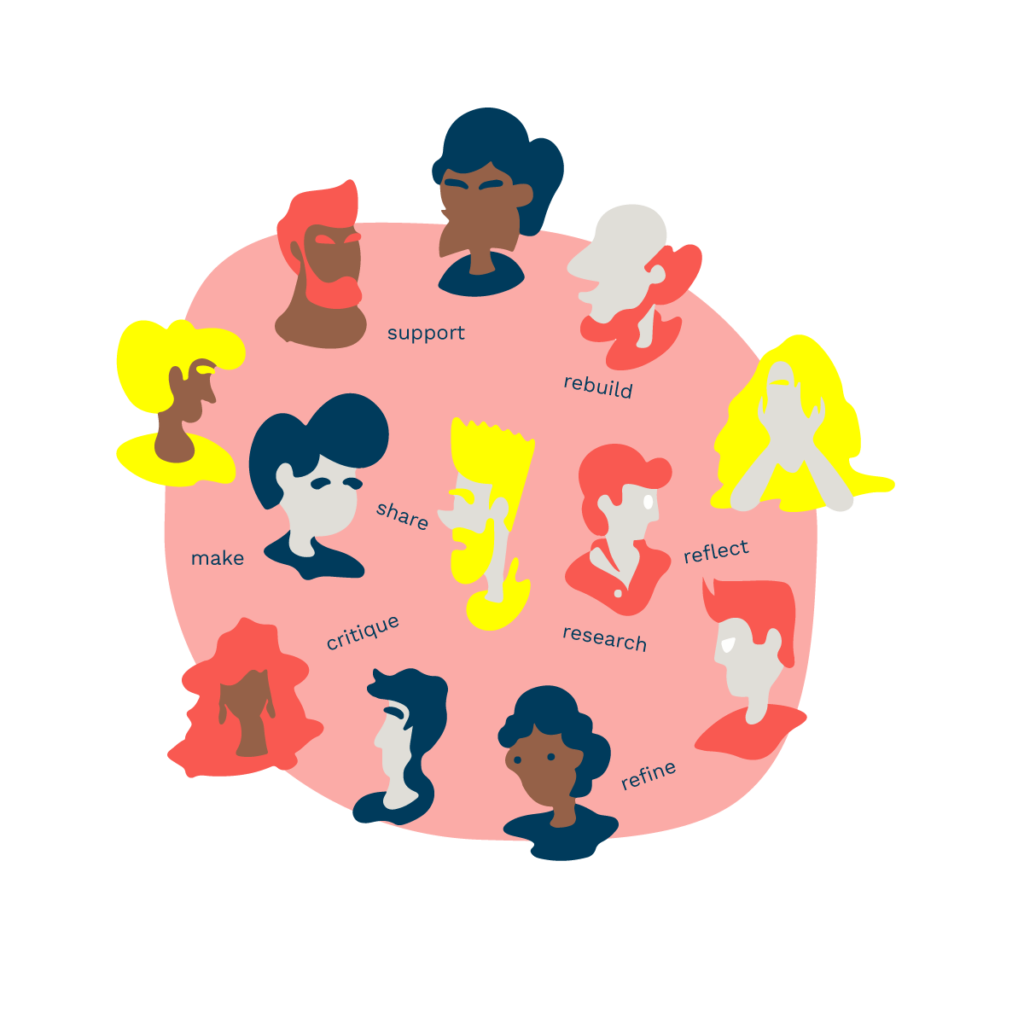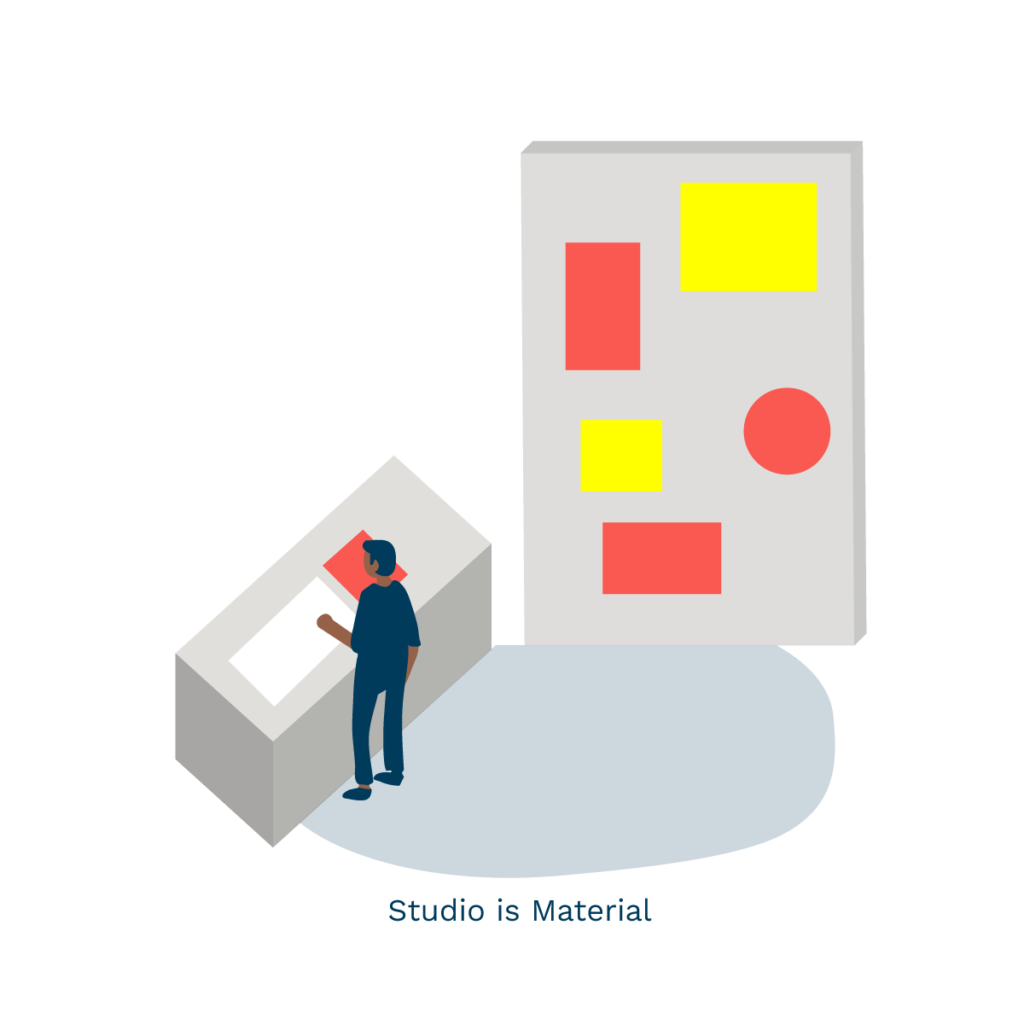Studio is a container term that holds many meanings for those of us with studio-based practices. This multiplicity of meanings is not troubling in its ambiguity because that container is irreducible to each of its parts, but we can unpack this variety to call attention to all of the ways a studio serves us. We can be precise when we examine what the studio offers us.
We’ve worked individually to communicate what each of us values about working, facilitating, and teaching in studios. Below those thoughts are clustered into loose categories, anchored in the concepts of space, time, people, and materials. The flow between these categories is truly what makes studio a magnificent idea worth considering, especially now. Before we consider all the complexity of those flows, we begin with these small windows.
Studio is Time
A studio induces commitment to the work
“Go to your studio” is a common admonishment in design circles. In this phrase is the conviction that once one enters into the studio space, the purpose of the space will result in work. Studios invite engagement with design by merely existing. When a designer enters a studio they might be compelled to organize, make markings, look at work, or think deeply about a recent event. The practice of saying yes to these inclinations is what keeps a designer in shape. It’s a designer’s vitality.
A studio is a process-oriented mechanism to generate outcomes.
The thing about studios is that you don’t know how it’s going to turn out. Even when you enter into a studio with clear objectives, it’s not uncommon to throw out those objectives as new discoveries along the way cause you to rethink and reframe what you are guiding towards, so we rely on process to get us there. We don’t know exactly where we are going but we do know how to navigate safely and effectively.
The funny thing about process is that this often ends up shifting as well. It’s common to enter with a plan for a series of activities only to find that what the studio effort needs is something else. This is not unlike an expedition discovering an unexpected lake. So you go back to your toolkit and break out a different set of traversal tools, loading what you need onto the boats and leaving behind cargo that’s become a hindrance.

A studio is an opportunity for intensive, wide-ranging inquiry.
We say intensive because in our experience, a burst of concentrated attention on a challenge leads to more fruitful results than an extended period of juggling priorities. There are diminishing returns to extending the inquiry. This is counter-intuitive.
We say wide-ranging because one of the things we look for studios to do is break people out of narrow fields of concern or narrow ranges of problem spaces.
A studio provides structured unstructured time
Individuals and groups working in a studio have dedicated time to allow for the creative process to take form with little to no road map. A studio is not rigid in its rules and processes and allows for dedicated time where happenstance and creative collisions can be noticed, explored, embraced, developed, and shelved.
A studio nourishes potentials and possibilities
A studio encourages the novel, unknowns without fear of “failure” by not just holding a multiplicity of tools and spaces that encourage creative exploration and experimentation; but by creating a safe and malleable environment for a community of creatives.
Studio is Space
A studio is close to field sites
Primary, observation based research in the field is an essential part of any design process, and it doesn’t just happen in the upstream stages of design. Consistent access to field sites for early stage observation and thick description is essential. This allows the designer to widen the scope of an inquiry and arrive at a transformative reframing of a problem or opportunity. Returning to the field site further downstream in the process to inject design probes or release design prototypes keeps work rigorous, validated and nimble.
A studio allows for fluidity
A studio provides avenues for one’s creative journey that can meander, pivot and change without breaking the creative process. The studio tools, space, and community are available to and distributed amongst those in a studio so that they each reach their creative and investigative potential.
A studio provides grounding during the creative process
As designers/creatives go through various stages in the design process – research, ideation, testing, connecting, discovering insights, making, critiquing and reflecting. The studio provides a space of familiarity and safety to ground ones thoughts and actions though this process. The studio is a safe space for continued practice that can be molded to what the context requires.
Studio is People
A studio is hospitable to visitors
One essential principle of design is that design artifacts and outcomes advance clarity of thought for both designers and those engaging with designs. Before the design process is complete, inviting others to visit the studio and engage with the work accelerates a designer’s ability to understand and validate their own thoughts. Hospitable spaces are those that welcome guests and welcome them into physical and mental engagement with the work.
A studio builds a community
A studio builds a community by being a shared space that holds tools to be shared. This creates a connection between individuals even though the space and tools might be used differently during individual creative processes. It allows for the praxis of multiplicity of uses and realities with a given object and given context.

A studio holds its community accountable
A (good) studio holds individuals accountable to their own growth and the development of others through critique, support, prototyping, making, refining, breaking, rebuilding etc. A studio and all it holds (both tangible and intangible) becomes “the commons” that is nurtured during the creative process. Tangible assets/tools, and space in a studio are treated as valuable assets in the creative process.
A studio community is self-motivated praxis
Those in a studio are motivated in the individual and collective creative praxis. A studio allows one to be present yet not beholden to a particular method, mode, idea or vision. A studio is conducive to putting into practice various methods, modes, ideas and visions in generative ways.
Studio is Material
A studio supports physical objects
A digital screen can be an essential tool in the design process, but a computer is not a studio. Horizontal space to make marks and manipulate materials greatly increases one’s ability to think at a slant, and display thinking to collaborators. Vertical space to display past work helps insights stay relevant as the momentum of each day carries the designer to new conceptual places. Maintaining a healthy flow from horizontal to vertical space, and archiving physical work for revisiting on future projects, builds a designers process and practice from project to project.

– Written by Katie Edmonds. Graphics by Jack Tufts. November 2020.
